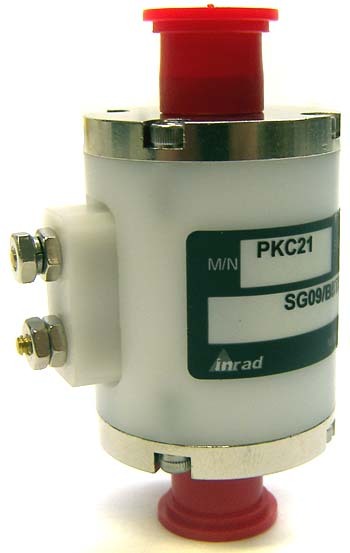Machine Parts For Reuse Newsgroup Discussion Forum > Large Size Parts
> Used
> Mechanical
> San Jose
> New inrad PKC21 pockels cell laser q-switch SG09 / bbts
New inrad PKC21 pockels cell laser q-switch SG09 / bbts
NEW INRAD PKC21 POCKELS CELL LASER Q-SWITCH SG09 / BBTS
Inrad Electro-Optic Pockels Cell Laser Q-Switch
INRAD KD*P Pockels cells have the electric field applied longitudinally along the direction of light propagation. Deuteration (KDP -> KD*P) has the dual effect of lowering absorption in the vicinity of 1 m as well as reducing the half wave voltage of the Pockels cell.
The insertion loss of KD*P Pockels cells is low due to the high intrinsic transmission of the crystalline material and effective reduction of reflective losses. INRAD offers several options for reducing the reflective losses in KD*P Pockels cells. Use of the index-matching fluid FC-43 is cost-effective and reduces the 4% per surface reflective loss at the crystal surface to 0.6% per surface. A near perfect index match, although at the expense of a more costly fluid, can be obtained with deuterated decalin to achieve < 0.1% / surface reflective loss. For higher fluence applications, where a fluid may not be viable, the surfaces of the crystal can be AR coated using a sol gel process to effect less than 0.5% reflective loss per surface. Hard dielectric AR coatings are applied to the exterior surfaces of the cell windows when a fluid-filled approach is taken, or to both sides of the windows when the crystal is AR coated.
The PKC21 is a standard Pockels cell, which is ideal for routine or demanding applications across the spectrum. Standard models are available with apertures of 9.5 mm, 12 mm, 15 mm, 20 mm, and 25 mm. Cells that are filled with index matching fluid are available for use at specific wavelengths between 300 nm and 1600 nm. For higher fluence applications, standard sol gel AR coatings can be specified for either 1064 nm or 800 nm with special wavelengths available on request.
The PKC02 is a dual crystal, capacitive Pockels cell that uses two crystals in series in order to reduce the size of the required high voltage. The two crystals share a common central electrical contact. With the crystals axially rotated by 90 with respect to one another, voltage from a single supply applied between the common center electrode and the end electrodes results in additive phase retardation. Access to all three electrodes is accessible through screw type connections.
Several Pockels cells, which are sold to original equipment manufacturers of lasers, can be purchased either as replacement components or as an economical means of satisfying a demanding application. Two such Pockels cells are the PKC23 and the PKC24 that have conveniently small packages.

